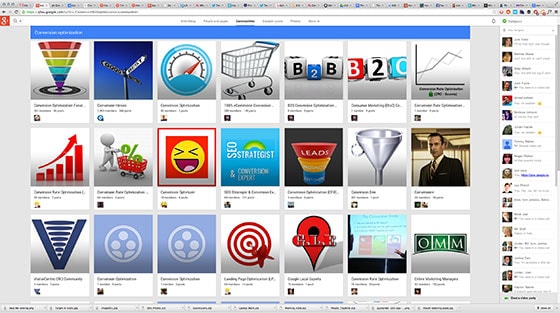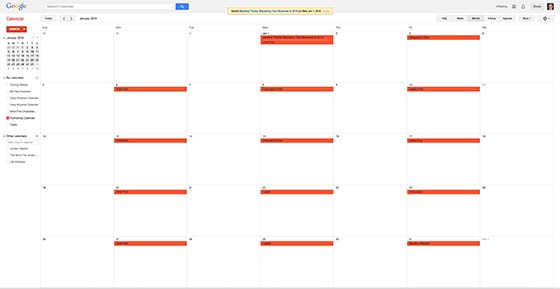Okay content marketers, I have a serious question for you…
Of all the content you created in 2013, how much did you plan strategically?
I’m not talking about writing a few blog post titles in a calendar a week in advance, but actually planning – who the content is for, where it will be seen, how it will be received. Style, format, tone, how everything works together – you know, strategic content.
Content marketers get so caught up in production, that we forget there’s a reason it’s called “content strategy”.
Before you know it, 2014 will be here. Don’t end up in the same production hamster wheel you’ve been on since 2009.
If you’ll humor me, I’d like to share the 5-step process I’ve developed for my clients that makes content more strategic, efficient and powerful.
Step 1: Sourcing Topics – Pick a Handful of Online Communities Base Your Content Strategy On What They Need.
When you create content, who are you creating it for?
I can’t explain it, but when something is created for you, it just feels different.
Ask any online writer that “speaks to you” how they do it, and they’ll likely tell you they read lots of comment threads, forums or social media groups about their particular subject.
As a writer, it’s much easier to create content for a small group of real people than it is to write for the abstract and faceless “audience” we talk so much about.
Seriously, check out Quora or use your main keywords in Google+ Communities or Linkedin Groups. There’s no shortage of real people asking questions that can be answered in an in-depth piece of content.

The best part is that with this methodology, sourcing topics and sourcing audience are one and the same.
When you consider that most mainstream memes are created by regular people sharing things with each other on Reddit, 4chan, 9gag & other forums, creating content for small groups can bring in very big audiences (even when the content is a little weird).
Matthew Woodward used a similar methodology to become a Technorati top 100 blog in less than a year by creating in-depth content for a handful of online communities.
Here’s what he had to say about it:
“I saw the same common problems coming up over and over. With my notes in hand I created possible tutorial titles and then bullet pointed the areas each tutorial should include. So I knew what my audience wanted and how I could help them. No PPC, no link building, no SEO, no media buys, no spending money – just good old fashioned human interaction.”
The people in those communities loved what he created so much, they don’t just share his content – they connect him with other influential people that help him take his career to the next level.
Step 2: Plan Your Content Themes By Month
Ever walk into a major retail store only to realize it was “that time of year?”
This month, in the U.S. at least, the theme will be feast and family (Thanksgiving). Next month it will be about the holidays. January will be about starting anew, and so on.
Themes are everywhere in our physical lives, but for some reason those themes rarely translate to online content.

While theming might seem like a minor detail, consider the sheer volume of disjointed information being broadcast this very second. With a monthly theme, you provide a much-needed anchor for readers that compel them to either:
- Stay tuned for the next article; or
- “Binge read” every article from a specific month
In either case, themes give you an entire month to build toward something bigger like a live webinar (more on that in the next section). With that built-in sense of anticipation and urgency, your visitors become more in tune and the path to conversion becomes more linear.
You could adopt themes of major industry events happening in a month, tie in national awareness months (like cancer awareness), or even create an awareness month of your own (Landing page awareness month anyone?)
Step 3: Determine How Your Content Works Toward A Larger Goal
After you select your monthly themes, it’s time to determine how the individual pieces of your content strategy will work together to drive people toward a larger monthly goal.
In this method of content planning, you’re not really relying on how headlines are ordered on the calendar. Instead, you’re planning content based on the smaller actions you’d like people to take, then gradually upping the commitment so they’ll take a larger action like becoming a lead or buying something.
This is why I suggest developing a content strategy where the individual pieces have 1 of 4 goals:
- Get Shared
- Drive Comments
- Attract Leads
- Make Sales
With your monthly calendar open, mark the days you plan to publish not by post title, but by the desired actions you’d like your readers to take.
That would look something like this:
Use these goals to guide you in measuring what works and creating individual pieces of content that serve a larger purpose.
Step 4: Select Media Formats & Styles That Suit Your Audience
Going back to the communities you’re following from Step 1, ask yourself what media formats they share the most? What drives the most responses?
Video?
Podcasts?
Ebooks?
Blog posts?
Infographics?
Slideshows?
If you’re not creating content in a format the community likes, you’re adding unnecessary friction to delivering your message.
Take it a step further and analyze the style and tone that generates the most response.
Are they sharing funny stuff, or are their tastes more serious? Long articles or short & pithy? Data-driven or conversational? Argumentative or relaxed? Hip and trendy or wise and authoritative?
9 times out of 10 content fails because it’s in front of the wrong people or delivered in a format your readers just don’t care for.
Step 5: Fleshing Out the Content Calendar
You’re finally ready to start creating an actual content calendar, with post titles and everything.
Using what we’ve gathered from before – common queries within groups, monthly themes, media formats & styles – open up the calendar with the content goals from Step 3, and start assigning potential titles and media formats to each publication date.
An example might look like:
January – Theme: Renewal
Monday
Goal: Viral Post
Format: Video
Topic: 15 Simple Things To Do To Get More Clients
Style: Short, hip, Buzzfeed-esque (No more than 1:30 runtime)
Distribution: Funky Freelancers (Facebook), Freelancing Freedom (Reddit), FreelanceFolder.com (blog)
——————————————
Wednesday
Goal: Discussion
Format: Blog
Topic: What I Learned From The Deals I DIDN’T close in 2013
Style: Conversational, Storytelling, Personal
Distribution: #FreelanceChat (Twitter), Freelanceswitch.com (blog), popularblogger@RelationshipYouveBuiltOverTime.com (email)
——————————————–
Friday
Goal: Viral Post
Format: Slideshow
Topic: 15 Freelancers Who Are Pushing the Boundaries in 2014
Style: Hip, bright colors, short actionable bites
Distribution: Slideshare, Funky Freelancers (Facebook), etc
(note – Add music and a few animations to redistribute to YouTube later)
—————————————————————
As you can see, this structure adds a lot more depth and sense of direction to the overall content calendar – providing you with a few key benefits:
Knowing media formats ahead of time helps you manage & prioritize your production schedule
Let’s say you know you want to create 24 slideshows, 12 videos, and 48 graphic quotes by the end of the year. That may seem like a lot, but that’s only 2 slideshows, 1 video, and 4 infographics a month.
Knowing that, it’ll be very easy to outsource those pieces that don’t require a lot of work from you or demand your full attention to create.
Sites like Odesk or Mturk are great low-cost resources for finding freelancers to do things like sourcing quotes, emailing pre-written interview questions or other important but otherwise time-sucking tasks that distract you from doing what you do best.
Having goals & style established in advance gives multi-author blogs a tactical advantage
Let’s say you’re the editor of a multi-author blog like Unbounce.
After a little research you find Stefanie’s content gets shared like wildfire, Oli drives the most comments, Georgiana typically gets more email subscriptions and Ryan generates the most sales.
By aligning your creator’s strengths with one of the four content goals, you empower the individual author to become an expert in serving that particular audience.
From a tactical standpoint, you’re always using “the best tool for the job.”
If you grow your team, or you work with guest bloggers, you’ll have a better idea of what kind of content to assign them, and how they’ll fit into your overall production calendar.
Picking distribution channels gives you time to work on outreach messages
Let’s not forget getting all of this content distributed. For a lot of us, the current outreach system looks like this:
- Create
- Publish
- Reach out
Problem is, this system doesn’t give any consideration to the content calendar of the person you’re reaching out to.
When you know what sort of content you’ll be creating months in advance and whom you’ll want to send it to, you can “seed” the idea with others and work your way more naturally into their content and curation rotation.
For example, let’s say I know I want to create that Buzzfeed-style video on getting more clients and I want to send it out to several freelancer communities.
I would get in touch with the different community and content managers a month or two in advance, let them know I was creating a video and maybe ask them for a tip I should include.
After the video is created, but before it’s made public, I would send them a private link, thank them for their input and let them know when it’s going live.
You could even use a tool like Boomerang – a “write an email now, send it later” app – to schedule the initial outreach messages. That way, when it gets closer to publishing time, you’re mobilizing the people who want to help, without wasting time emailing those who don’t care.
Discussion
Well, there you have it: 5 steps to improving your content marketing strategy in 2014.
How does that stack up against what you’re currently doing? Anything you can add to make it better?
Can’t wait to hear your thoughts!



